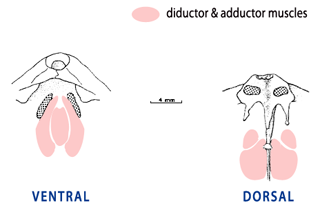|
Gyrothyris mawsoni Thomson, 1918
Type locality: “one mile off south end of Macquarie Island.”
Depth range: 79 - 563 m
Gyrothyris mawsoni antipodesensis Foster, 1974
Gyrothyris mawsoni aucklandensis Foster, 1974
Note: Tomson (1918) wrote: “Gyrothyris resembles Pachymagas more than Terebratella, but, differs from the former, in the absence of beak ridges, the shallowness of the hinge trough, and the transverse nature of the cardinal process. Further, Gyrothyris mawsoni possesses a radial ornament which has never been observed on any species of Pachymagas.”
According to Bowen (1968), “the Macquarie Island specimens of G. mawsoni resemble Magasella sanguinea but lack its characteristic reddish colour. On the inside, the shell structures are more thickened than in M. sanguinea.”
Diagnosis in preparation -
Should be added:
Muscle disposition: see Fig. in front - dorsal pedicle adjustor muscle bases not located at the anterior edge of the hinge plate
|

Muscle attachment (modified, from Foster, 1974 - with absence of separate posterior accessory diductor muscles base, the pair of ventral adductor muscle bases in a single unit)
|


